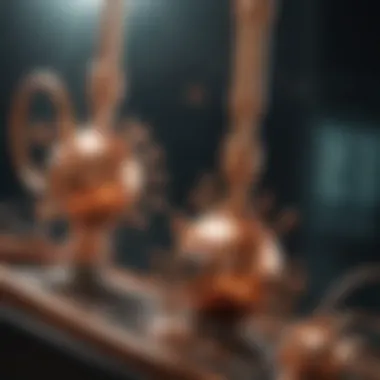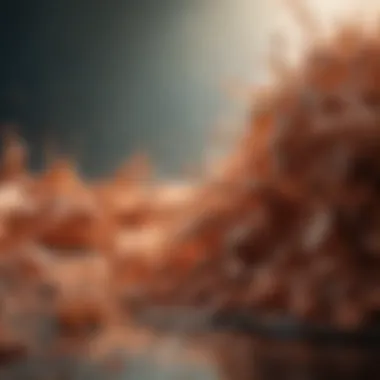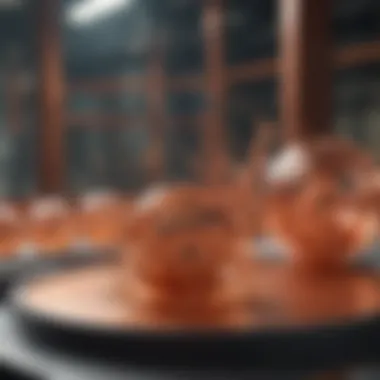Exploring Copper and Oxygen: Chemical Interactions


Intro
Understanding the chemistry of copper and its reactions with oxygen unveils a myriad of processes crucial for both natural phenomena and industrial applications. Copper, a transition metal, readily reacts with oxygen, producing various compounds, which display different oxidation states. This behavior has significant implications, from corrosion resistance in materials engineering to its role in environmental chemistry.
In this article, we will delve into how copper interacts with oxygen, covering key reactions, mechanisms involved, and the significance of oxidation states. The narrative aims to bridge theoretical concepts with practical applications, providing readers a comprehensive overview that effectively communicates the importance of copper-oxygen interactions in multiple fields.
Research Context
Background and Rationale
Copper is highly valued in many industries due to its excellent electrical and thermal conductivity. The reactions of copper with oxygen have been studied extensively across various scientific disciplines. Understanding these reactions is vital; they affect copper's properties and utility in different environments. When copper oxidizes, it can achieve several oxidation states, commonly +1 and +2, leading to diverse products. This variability underlines the importance of a detailed exploration of the underlying chemistry.
Literature Review
Several studies have concentrated on the oxidation of copper, documenting both the kinetics of the reactions and the unique characteristics of different copper oxides. Previous research, such as the works by T. D. Lee and R. A. Miller, demonstrates the intricate balance between reaction conditions and product formation. Moreover, advanced theoretical models are emerging, which aim to predict the outcome of copper-oxygen interactions under various environmental factors. The literature suggests that there are still gaps in our understanding, particularly concerning the impact of temperature and atmospheric composition on these reactions.
"The study of copper's interactions with oxygen not only hones our understanding of its fundamentals but also inspires industrial innovations that hinge on these principles."
Methodology
Research Design
This article synthesizes existing literature and empirical findings to construct a detailed and coherent narrative on copper-oxygen chemistry. Through systematic analysis, we seek to create an integrated overview that highlights both theoretical and practical aspects of these reactions.
Data Collection Methods
Data for this exploration will be gathered from peer-reviewed journals, institutional publications, and reputable scientific platforms such as Wikipedia and Britannica. By consolidating findings from multiple sources, we aim to provide a well-rounded perspective on this dynamic field.
Intro to Copper and Oxygen Chemistry
In this section, we will explore the history of copper's use, as well as the critical role oxygen plays in its chemical behavior. Through the lens of historical and chemical importance, we will set the stage for a thorough examination of the complexities surrounding copper-oxygen reactions. The insights gained here will serve as a foundation for further discussions in later sections of this article.
Historical Context of Copper Use
Copper has been utilized by humanity for thousands of years. Its discovery marked a significant milestone in metallurgy and civilization, often referred to as the start of the Chalcolithic, or Copper Age. Early societies recognized copper's malleability and resistance to corrosion which made it ideal for tools, weapons, and ornamental items.
As civilizations advanced, the importance of copper only grew. By the time of the Bronze Age, the combination of copper with tin led to the creation of alloys that were stronger and more durable. The process of smelting copper ores and refining copper metal laid the groundwork for various advancements in technology and trade routes.
Today, copper remains a fundamental material, with vast applications ranging from electrical technology to sustainable energy solutions. It holds a unique place in human history, not only for its characteristics but also for its contribution to economic and societal development.
The Role of Oxygen in Chemical Reactions
Oxygen is a vital element in many chemical reactions, particularly those involving metals like copper. Its presence can significantly alter the behavior of substances. In the context of copper, oxygen is crucial for understanding oxidation processes. When copper is exposed to oxygen, it tends to oxidize, which leads to the formation of copper oxides.
These copper oxides have distinct properties and applications. For example, copper(I) oxide and copper(II) oxide differ in their chemical behavior and uses. The introduction of oxygen creates an environment in which these transformations can take place, emphasizing the dynamic interaction between these two elements.
In summary, the interaction of copper and oxygen is not merely a matter of academic curiosity; it has profound implications that extend into practical applications, industrial processes, and environmental considerations. As we delve deeper into this topic, we will explore the specific reactions, mechanisms, and influences that govern the behavior of copper in the presence of oxygen.
The Basics of Copper Chemistry
Understanding the basics of copper chemistry is essential for the overall grasp of copper-oxygen interactions. Copper stands out not just for its practical uses but also for its fascinating chemical behavior. This section will provide insights into both the physical and chemical properties of copper, which lay the groundwork for further discussions in this article.
Physical Properties of Copper
Copper is a ductile and malleable metal, making it easy to shape and form into various applications. Its high thermal and electrical conductivity make it indispensable in electronics. The melting point of copper is about 1,984°F (1,085°C), while its boiling point reaches approximately 4,644°F (2,563°C). These properties reflect a metal that can withstand high temperatures without losing integrity.
Some additional key physical characteristics of copper include:


- Color: Copper has a distinct reddish-brown color.
- Density: It has a density of about 8.96 g/cm³, contributing to its heavy feel.
- Corrosion resistance: Although it can oxidize, copper naturally forms a protective patina which helps avoid further corrosion.
Copper's unique properties make it valuable in several applications, including electrical wiring, roofing, and plumbing, thus highlighting its practical significance in our daily lives.
Chemical Properties of Copper
The chemical properties of copper are equally important in understanding its reactions, especially with oxygen. Copper can exhibit multiple oxidation states, primarily +1 and +2, which are relevant in various chemical reactions. This versatility in oxidation states allows copper to participate in a variety of chemical processes.
Some notable chemical properties of copper include:
- Reactivity: Copper does not react vigorously with air or water at room temperature. However, it can oxidize when heated in the presence of oxygen, forming copper(I) oxide or copper(II) oxide.
- Acid reaction: Copper reacts with strong acids, such as sulfuric acid or nitric acid, leading to the release of hydrogen gas in some cases.
- Formation of Complexes: Copper can form coordination complexes with various ligands, affecting its solubility and behavior in solutions.
These characteristics of copper help to establish a framework for understanding the interactions that take place when copper reacts with oxygen, which will be elaborated upon in the subsequent sections.
The Reaction of Copper with Oxygen
The reaction of copper with oxygen holds significance in both theoretical and practical realms of chemistry. Understanding how these two elements interact is fundamental for a comprehensive grasp of copper chemistry. The reaction creates a variety of compounds that have essential applications in industrial processes and environmental studies. Insight into this topic enables us to appreciate the versatile roles of copper oxides and their behaviors under different conditions.
Basic Reaction Overview
The reaction between copper and oxygen is relatively straightforward. When copper metal is exposed to atmospheric oxygen, it initiates an oxidation process. The basic reaction can be summarized by the equation:
[ 2Cu + O_2 \rightarrow 2CuO ]
This equation shows the direct formation of copper(II) oxide, commonly known as cupric oxide. However, the temperature, presence of other substances, and various environmental factors can alter the outcomes. For example, in reducing conditions or at elevated temperatures, copper(I) oxide may form instead of copper(II) oxide.
Factors influencing the reaction include:
- Temperature: Higher temperatures typically enhance the reaction rate.
- Oxygen Concentration: Increased oxygen presence can favor oxidation processes.
- Presence of Catalysts: Some materials can accelerate the reaction without undergoing any change themselves.
Oxidation and Reduction Mechanisms
The mechanisms behind the oxidation of copper are complex. At the core of these processes are oxidation and reduction reactions, which are complementary. During oxidation, copper loses electrons, resulting in the formation of positive copper ions. The oxygen gains those electrons, reducing the molecular oxygen to oxide ions.
In a simple reaction without external influence, copper metal oxidizes as follows:
- Oxidation of Copper:
- Reduction of Oxygen:
"Understanding the mechanisms of copper oxidation not only catalyzes advancements in industrial applications but also fosters further research in environmental science."
Thus, delving into the reaction of copper with oxygen unveils essential insights necessary for students, researchers, and professionals in the field. It illustrates how micro-level reactions contribute to macro-level applications.
Factors Influencing the Reaction
Understanding the factors that influence the reaction between copper and oxygen is vital for comprehending how these elements interact at a chemical level. Environmental conditions and reaction settings play a crucial role in determining the rates and outcomes of these reactions. Various parameters, such as temperature, oxygen concentration, and the presence of catalysts, significantly affect how copper reacts with oxygen. Each of these elements not only alters the nature of the reaction but also influences the final products and their properties.
Temperature Effects
Temperature is a primary factor impacting the rate of chemical reactions. In the context of copper reactions with oxygen, increasing temperature generally accelerates the reaction. This is due to the higher kinetic energy of the particles involved, leading to more frequent and more forceful collisions between copper and oxygen molecules.
As the temperature rises, the likelihood of copper atoms transitioning into higher oxidation states increases. This can lead to the formation of different copper oxides, such as Copper(I) oxide and Copper(II) oxide. Additionally, extreme temperatures can result in phase changes in the copper itself, influencing its reactivity.
In practical applications, temperature control is crucial. In industrial settings where copper oxidation is utilized, maintaining an optimal temperature can maximize the efficiency of processes such as the production of copper oxide coatings or materials.
Concentration of Oxygen
The concentration of oxygen available in the reaction environment greatly affects the course of copper reactions. A higher concentration of oxygen facilitates and speeds up the oxidation process. Oxygen molecules readily react with copper to form various oxides depending on the conditions.
When oxygen concentration is low, copper can fail to undergo complete oxidation, which can lead to a variety of intermediate compounds. Conversely, at high concentrations, the reaction can lead to the formation of stable oxides, impacting the physical and chemical properties of the resultant materials.
In environments where oxygen levels can be controlled, such as in closed systems or reactors, understanding this relationship is critical. This principle is crucial for applications like metallurgy and materials engineering, where having specific oxides with desired properties is essential.


Presence of Catalysts
Catalysts play an integral role in facilitating chemical reactions without being consumed in the process. Specific substances can be introduced to enhance the copper-oxygen reaction, often leading to increased reaction rates or altered pathways.
The presence of catalysts may allow for lower temperatures to achieve the same reaction rates, thus reducing energy consumption in industrial settings. For instance, metal oxides such as manganese dioxide have been shown to increase the efficiency of copper oxidation.
The study of catalysis in copper reactions extends to explore how various substances can selectively promote the formation of desired copper compounds. Understanding the type of catalyst and its mechanism is essential in refining processes and achieving optimal product characteristics.
The reactivity of copper with oxygen can be significantly altered by controlling temperature, oxygen concentration, and the presence of catalysts, each playing a critical role in the outcomes of these reactions.
Products of Copper-Oxygen Reactions
The study of copper-oxygen reactions reveals crucial insights into the nature of these interactions, especially regarding the products formed. Understanding these products is vital for grasping the broader implications of copper chemistry in various fields, including materials science and environmental studies. The primary product of reactions between copper and oxygen are copper oxides, but other compounds can also arise from this reaction depending on the conditions.
Formation of Copper Oxides
The formation of copper oxides is a key outcome in the interaction of copper with oxygen. Copper oxides can be categorized into two primary forms: Copper(I) oxide and Copper(II) oxide. Each of these oxides has its own distinct properties and ramifications.
Copper() oxide
Copper(I) oxide, also referred to as cuprous oxide, has a notable role in various applications due to its electronic and catalytic properties. Its main characteristic is that it possesses a +1 oxidation state of copper. This particular oxidation state is relatively unstable in comparison to its counterpart, Copper(II) oxide.
One significant advantage of Copper(I) oxide is its ability to be used in photovoltaic cells. This contributes to the growing field of renewable energy. Despite its advantages, Copper(I) oxide can be susceptible to oxidation when exposed to air, converting it to Copper(II) oxide, which limits its stability in some applications.
Copper() oxide
In contrast, Copper(II) oxide, or cupric oxide, is more stable and is characterized by having copper in a +2 oxidation state. This stability makes Copper(II) oxide a preferred material in various industrial processes, especially in the manufacturing of ceramics and pigments.
One major benefit of Copper(II) oxide is its antiseptic properties. This characteristic positions it well for applications in the health sector, including its potential use in wound dressings. However, it is essential to keep in mind that Copper(II) oxide can pose environmental concerns if not handled correctly during certain industrial operations.
Other Possible Compounds
Beyond the primary copper oxides, several other compounds may arise from copper's reaction with oxygen, depending on environmental conditions. These may include complex oxides or oxyacids that result from varying oxidation states and reactions with additional elements.
Understanding these other possible products is essential for advancing the comprehension of copper's role in chemical processes and can shed light on its broader applications in various sectors. The diversity of oxidation states and the compounds formed emphasize the importance of copper in both foundational and applied chemistry.
Characterization of Copper Oxides
Characterization of copper oxides is crucial to understand the behavior and properties of these materials. In the context of copper reactions with oxygen, identifying the specific types of copper oxides formed has implications across various fields, including environmental science and industrial applications. Characterization helps in determining the oxidation states of copper, aiding in the prediction of chemical behavior and potential reactivity in different environments.
Analytical Techniques
Spectroscopy
Spectroscopy plays a significant role in analyzing copper oxides. This technique allows researchers to study the interaction of copper oxides with electromagnetic radiation, yielding valuable information about their molecular and electronic structure. A key characteristic of spectroscopy is its ability to provide insights into the energy levels of electrons in the copper oxides. It is a popular choice for researchers because of its precision and versatility in identifying different phases of copper oxide.
One unique feature of spectroscopy is its non-destructive nature. Researchers can analyze samples without altering their composition. However, spectroscopy can have limitations, such as sensitivity to sample preparation and potential interference from other substances in complex mixtures.
X-ray Diffraction
X-ray diffraction is an essential technique for characterizing the crystalline structure of copper oxides. This method relies on the diffraction of X-ray beams when they encounter atomic planes within a crystalline material. A key characteristic of X-ray diffraction is its ability to determine lattice parameters and crystallite size, providing insights into the structural integrity of copper oxides. This makes it a valuable method in this article as it assists in distinguishing between various copper oxide phases.
The unique feature of X-ray diffraction is its high resolution in revealing the arrangement of atoms and the identification of crystal structures. However, it has its disadvantages, including the requirement for a crystalline sample, which can limit the analysis of amorphous materials.
Physical Properties of Copper Oxides
The physical properties of copper oxides are fundamental for their applications in various fields. These properties include conductivity, thermal stability, and color, which can change with different oxidation states. Understanding these characteristics helps in tailoring copper oxides for specific uses, such as semiconductors or catalysts.
Practical Applications of Copper-Oxygen Reactions


Copper-oxygen reactions play a pivotal role in various practical applications that are essential in both industry and environmental science. The significance of understanding these reactions lies in their direct impact on manufacturing processes, material properties, and the environment. Companies leverage the properties of copper reactions with oxygen to innovate and improve product efficiency. Meanwhile, the resulting compounds have implications that extend to environmental concerns, emphasizing the need for responsible practices.
Industrial Manufacturing Processes
In the industrial sector, copper and its oxides are critical for a wide range of manufacturing processes. For example, the formation of copper oxides through oxidation reactions is often utilized in the production of semiconductors. These materials, characterized by their semiconductor properties, are integral for the production of electronic components, such as diodes and transistors.
Additionally, copper oxides are used in producing catalysts for chemical reactions. For instance, the Copper(II) oxide serves as a catalyst in various reactions, enhancing the efficiency of production. In metallurgy, copper is essential in alloy production, and the oxidation states can influence alloy properties.
- Benefits of copper in manufacturing include:
- High thermal and electrical conductivity.
- Corrosion resistance when alloyed with other metals.
- Eco-friendliness due to its recyclability.
This versatility shows how a deeper understanding of copper-oxygen reactions can lead to advancements in manufacturing technologies, reducing costs and environmental impacts while enhancing product quality.
Environmental Impact
The reactions of copper with oxygen also carry significant environmental implications. One major concern is related to the oxidation of copper and the formation of copper oxides in the atmosphere. These compounds can affect air quality and contribute to environmental toxicity.
- Key considerations for minimizing environmental impact:
- Implementing effective waste management systems to reduce copper emissions.
- Recycling copper to limit the need for mining, thus reducing ecological disruption.
- Developing regulations to manage copper usage and its byproducts in manufacturing and waste management.
"Understanding the environmental impacts of copper-oxygen reactions is crucial for developing strategies that balance industrial needs with ecological preservation."
In summary, the practical applications of copper-oxygen reactions are numerous, influencing not only industrial advancements but also prompting discussions on environmental sustainability. Striking a harmony between usage and environmental health remains a challenge, necessitating continued research and awareness.
Theoretical Perspectives on Copper Reactions
Theoretical perspectives on copper reactions with oxygen are fundamental to understanding the various complex processes involved. These reactions not only highlight the fundamental principles of chemistry but also illustrate their practical implications in industry and environmental sciences. By focusing on thermodynamics and kinetics, we can gain insights into how these reactions occur under various conditions and the factors influencing their outcomes.
Thermodynamics of the Reaction
Thermodynamics plays a critical role in analyzing the feasibility and extent of copper oxidation reactions. At its core, thermodynamics helps to determine the energy changes that occur during chemical processes. The main concepts involved are enthalpy, entropy, and Gibbs free energy.
- Enthalpy Change: The reaction between copper and oxygen is exothermic, releasing heat. This suggests that the products formed are more stable than the reactants.
- Entropy Considerations: As gases and solids interact during oxidation, the change in entropy must also be evaluated. Generally, gas formation increases entropy, enhancing the spontaneity of the reaction.
- Gibbs Free Energy: This determines whether the reaction will proceed spontaneously. A negative Gibbs free energy indicates that the reaction is thermodynamically favorable.
Understanding these thermodynamic parameters helps in predicting reaction behavior even under different temperature and pressure conditions. Exploring these interactions gives insights into the efficiency of industrial processes that depend on copper oxidation.
Kinetics of Copper Oxidation
Kinetics focuses on the reaction rates and mechanisms behind the copper-oxygen interactions. The rate at which copper oxidizes is influenced by several factors. Understanding these can optimize reactions in real-world applications.
- Reaction Rate Influencers:
- Mechanisms of Reaction: The kinetics of copper oxidation can be understood through various proposed mechanisms. For example, the formation of an initial oxide layer can inhibit further oxidation, leading to a so-called passivation process.
- Temperature: Higher temperatures increase kinetic energy, thus speeding up reaction rates.
- Surface Area: Finely divided copper reacts more swiftly than larger pieces due to increased surface exposure.
- Concentration of Reactants: Increased concentration of oxygen can enhance the rate of oxidation as it provides more reactant molecules.
Epilogue
In summarizing the complex interactions between copper and oxygen, this article highlights the significance of understanding these chemical reactions. The interplay between these two elements reveals not only fundamental principles of chemistry but also practical implications across various fields.
Summary of Key Points
The following key points emerge from the discussions in this article:
- Historical Context: Copper has been used by humans for thousands of years, illustrating its importance in technology and culture.
- Oxidation and Reduction Mechanisms: The reactions of copper with oxygen involve intricate mechanisms that highlight the concepts of oxidation states and electron transfer.
- Factors Influencing Reactions: Temperature, concentration of oxygen, and catalysts can significantly affect the rate and outcome of copper oxidation.
- Products Obtained: The reaction forms various copper oxides, including Copper(I) oxide and Copper(II) oxide, which have unique properties and applications.
- Characterization Techniques: Advanced methods such as spectroscopy and X-ray diffraction play a vital role in understanding the structure and properties of copper oxides.
- Practical Applications: These reactions have notable implications in industrial processes and environmental studies, showcasing the importance of copper chemistry in real-world scenarios.
- Theoretical Perspectives: Insights from thermodynamics and kinetics provide a deeper understanding of the processes at play during copper oxidation.
Future Directions in Research
As we look to the future, several areas warrant further investigation:
- Nano-Copper Research: Exploring the behavior of copper at the nanoscale could unveil new properties and applications.
- Sustainability Studies: Investigating methods to minimize the environmental impact of copper production and oxidation might lead to more eco-friendly practices.
- Innovative Catalysts: Identifying and developing new catalysts can enhance the efficiency of copper oxidation, benefiting industrial applications.
- Advanced Characterization Techniques: Utilizing state-of-the-art methods could improve our understanding of the underlying chemical processes.
- Interdisciplinary Approaches: Collaboration between disciplines, such as chemistry, environmental science, and materials engineering, can foster innovative solutions based on copper-oxygen interactions.
These various future research pathways promise to deepen our understanding of copper's chemistry and refine its applications.
By comprehending the nuances of copper reactions with oxygen, researchers and professionals can leverage this knowledge for advancements in technology and sustainability.



